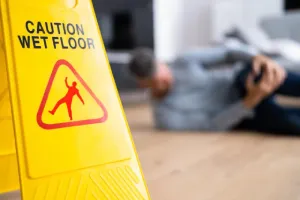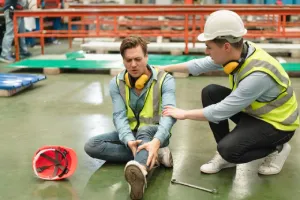Flooring, Anti-Slip Mats, Cleaning Schedules
Why This Matters
Slips, trips, and falls remain one of the leading causes of workplace injury in the UK, responsible for over 30% of reported incidents (HSE). As a security officer, you are often first to spot unsafe conditions and are expected to take immediate, practical action.
Flooring quality, the use of anti-slip mats, and the timing of cleaning schedules are all critical factors in preventing accidents. These measures are not just about compliance — they show professionalism, protect staff and visitors, and help you maintain your SIA licence.
Flooring Hazards to Watch For
Different types of flooring carry different risks:
Polished surfaces (like marble or tiles) look smart but become slippery when wet.
Carpets can fray or bunch up, creating trip hazards.
Uneven or damaged flooring (loose tiles, broken slabs, worn steps) often cause accidents if ignored.

Tip: During patrols, always scan walkways, entrances, and staircases for surface defects. If you spot a hazard, report it immediately and, where possible, restrict access until it is fixed.
Anti-Slip Mats: Small Tools, Big Impact
Anti-slip mats are a simple but highly effective way to control risks, especially in high-footfall areas such as entrances and kitchen zones.
Where they work best: Doorways on rainy days, areas prone to spills, kitchens, or places with smooth flooring.
What to check: Mats should lie flat, be clean, and free from curled edges. A mat that slips or folds becomes a hazard itself.
Standards to remember: NSI and BSI guidelines encourage the use of suitable anti-slip products in identified risk areas.

Key consideration: If you notice missing or damaged mats, raise it with facilities management. Never ignore a rolled edge or loose mat — that’s an accident waiting to happen.
Cleaning Schedules: Timing is Everything
Cleaning keeps sites safe, but it can also create hazards if poorly managed.
Wet mopping during busy hours without signage puts people at immediate risk.
Overlooking high-risk areas (entrances, stairwells, toilets) increases accident potential.
No coordination with site teams leads to hazards being missed or ignored.
Best practice:
Cleaning should take place during quieter times whenever possible.
Temporary barriers and “Wet Floor” signs must always be used.
Security officers should communicate with cleaning teams and log unsafe cleaning practices.
Real-World Example
You’re patrolling an office block on a rainy afternoon. You notice the floor at the main entrance is wet and slippery, but there’s no anti-slip mat and no signage.
If you ignore it: A visitor slips, injures themselves, and makes a claim. CCTV shows the hazard was visible but unattended.
If you act: You request a mat, place a temporary barrier, log the hazard, and notify cleaning staff. The area is safe within minutes.
Your quick action prevents injury, protects the business, and shows your competence as a security professional.
Common Mistakes to Avoid
Even experienced officers can fall into bad habits. Watch out for these pitfalls on patrol:
Damaged mats left in place
A frayed edge or rolled-up corner isn’t just untidy — it’s a trip hazard waiting to happen. If you see it, report it or remove it.Mopping during peak times without signage
A freshly mopped floor looks clean… but without a “Wet Floor” sign, it’s also an accident hotspot. Always check cleaners are using the right warnings.Ignoring worn or broken flooring
Thinking “someone else will report it” is dangerous. A loose tile or cracked step can cause injury — and you’ll be asked why you walked past it.Poor-quality or unstable mats
Mats that don’t absorb water, or worse, slide on smooth floors, create more risk than they prevent. Secure them or have them replaced.
Remember: spotting and acting on these mistakes is part of your professionalism. Small details can stop big incidents.
Consequences of Poor Practice
Cutting corners with flooring, mats, or cleaning might feel harmless in the moment — but the fallout can be serious.
For people: A wet floor or damaged mat can mean slips, trips, broken bones, or worse. These are real injuries to staff, visitors, or contractors who trusted the site to be safe.
For the business: One avoidable accident can trigger compensation claims, legal fines, insurance hikes, and reputational damage. A single bad headline can undo years of good work.
For you: If it’s found you ignored a hazard, you could face disciplinary action, lose professional trust, and even risk your SIA licence — your ticket to working in the industry.
Bottom line: Poor practice hurts everyone. Your vigilance keeps people safe, protects the business, and safeguards your career.
Poor vs Good Practice
| Poor Practice | Good Practice |
|---|---|
| Leaving a frayed carpet in a busy corridor. | Reporting and cordoning off damaged flooring until repaired. |
| Allowing a wet floor after cleaning with no signage. | Ensuring “Wet Floor” signs and barriers are in place until the area is dry. |
| Using a curled anti-slip mat at an entrance. | Ensuring mats are flat, secure, and replaced if damaged. |
Scenario for Practice
While patrolling, you see that cleaners are mopping a main stairwell during the lunch rush, and no barriers or signs have been placed.
What immediate action would you take?
How would you communicate with the cleaning team?
How would you record this in your Daily Occurrence Book (DOB)?
Think about how your intervention protects both people and your employer.
Small Actions, Big Impact
Safe flooring, well-placed anti-slip mats, and smart cleaning schedules aren’t “extras” — they’re the basics of keeping people safe. As a security officer, the difference is in the details you notice and act on.
By staying alert, you:
Protect people — preventing avoidable slips, trips, and painful injuries.
Protect the business — avoiding costly claims, fines, and reputational harm.
Protect yourself — showing professionalism, safeguarding your SIA licence, and proving your value on site.
Stay sharp. Stay proactive. Stay safe.
Because the smallest action — like placing a mat or spotting a loose tile — can prevent the biggest accidents.

